Awning Styles
Choose a fabric awning style that fits your business decor – contemporary or classic.
There are many designs, styles, fabrics, colors, features and options available in awnings today. Your professional awning supplier can provide you ideas and budgets for the awning that fits your needs.
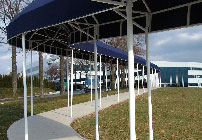
Canopy – A canopy, unlike an awning, is supported by not less than one stanchion at the outer end, as well as the building to which it is attached. Like an awning, it is made of fabric and can provide the same benefits and aesthetics of an awning.
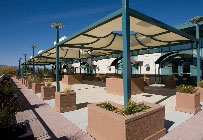
Free-Standing Canopy – This canopy, is supported by stanchions at the outer end and not attached to a building. Like an awning, it is made of fabric and can provide the same benefits and aesthetics of an awning.
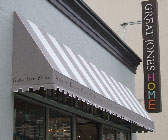
Traditional – The traditional frame is comprised of a down-slanting front panel with or without two side panels or ends. It can be used over smaller areas like windows and entryways, but can also provide protection over large areas like porches, patios and decks.
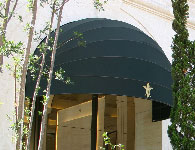
Dome – A dome-shaped awning is typically found over small entryways and windows and can be used in archways. The quarter-sphere shape provides similar protection from the sun and rain from all angles.

Elongated Dome – Similar to the dome-shaped frame, this style works best for long windows or entryways that require a dome awning. The elongated dome can be used on a flat surface or can curve to cover a corner entry or windows.
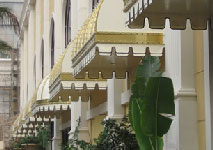
Quarter Round / Convex – The quarter round frame is similar to the traditional awning with flat side panels, but is characterized by a curved front panel, constructed from a series of parallel bows in the shape of a convex curve. It produces a radius shape with flat ends. It is best used over a small entryway or window.

Lateral Arm / Retractable – Most typically used over patios and decks, the retractable awning can be extended and retracted to provide shelter when necessary and allow sunlight when desired. It includes a manual cranking system or two variations of electric control systems; one functions at the push of a switch or button and the other can be controlled by sun, wind and rain sensors.

Concave – Most typically used over a window or door, the concave design is characterized by the inward curvature of the front panel. The side panels can be covered with fabric for a completely shaded enclosure, or left open, leaving the front panel supported by decorative poles.
Types of awnings – a variety of shapes, sizes and styles.
A fabric awning can be purchased in a standard size or custom made to fit your specific need and application. Awnings are commonly used over windows and doorways as well as providing shade over patios and decks.
Fabric Awnings and canopies
An awning is an architectural fabric projection that provides weather protection, identity or decoration and is wholly supported by the building to which it is attached. An awning is comprised of a lightweight frame structure over which a cover is attached. A canopy is also supported by the building to which it is attached but includes at least one or more stanchions that support the outer end.
There are two types of awnings – retractable and stationary.
Retractable awnings – a variety of great features!
With the push of a button, a retractable awning can create an instantly cool and relaxing haven from the sun’s rays. In addition, retractables are extremely user-friendly.
Depending on your budget and need, select manual or automatic, remote or sensor-activated controls that allow awnings to be easily opened and closed from inside and outside
Sensor-controlled awnings feature wind and sun sensors that will automatically retract or extend the awning – even when nobody is home.
Stationary awnings – customize with style and classic design
Fixed frame awnings are a popular choice because they can be custom fit to your outdoor space. Ideal for odd shapes, bump outs, and window sizes – custom designed stationary awnings give great creativity in style, size and shape.
Stationary awnings are ideal for entryways and windows and balconies. They require less maintenance than retractable awning because there are no moving parts.
 TEXTILES.ORG
TEXTILES.ORG 


